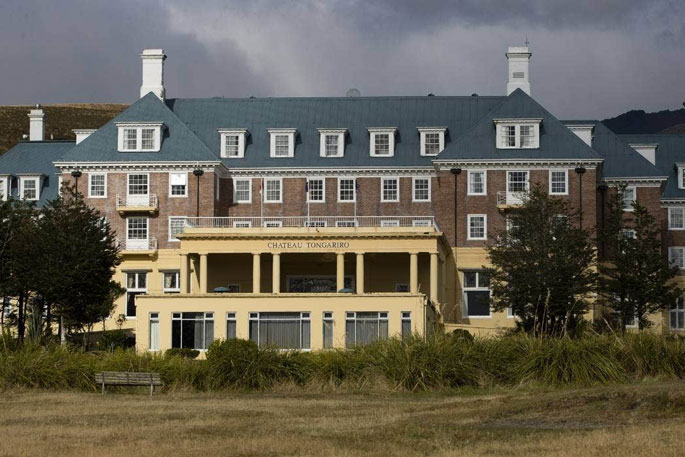As the Chateau Tongariro doors shut seven years shy of its centenary, it joins a growing list of historic tourism buildings closed by earthquake regulations.
Rotorua's grand Tudor-style museum and Blue Baths, like the iconic ski lodge, are exemplars of the golden age of New Zealand tourism when the Government spent and built lavishly to lure well-heeled adventurers to our shores.
Now the buildings that filled tourists' albums for more than a century sit idle and cordoned off due to rules that sprung out of the collapse of badly designed 1980s structures in the Christchurch quake.
Is the risk real or have we gone too far down the safety path at the expense of our built heritage and tourism offering?
According to Dr Esther Aigwi, Auckland University of Technology School of Future Environments lecturer, the question of whether we risk losing too many heritage buildings unnecessarily can be answered in one word: 'Absolutely.”
'The 2010/2011 Canterbury earthquakes revealed the risk of losing a significant proportion of New Zealand's heritage buildings and precincts to abandonment and demolition,” she says.
It's not just earthquakes putting our built heritage at risk, however.
'Before the Building (Earthquake-prone Buildings) Amendment Act 2016 was introduced, many heritage buildings in New Zealand, especially in provincial areas, were already experiencing high vacancy due to the soaring cost of maintaining and conserving significant heritage features.
'So apart from earthquakes, the heritage buildings in New Zealand are also threatened by fires, housing development activities, and ‘demolition by neglect', which may all be interrelated in most cases.”
Aigwi says it's simply inevitable that buildings the age of the Chateau, and older, will not meet modern seismic safety standards.
There is some good news however, from Aigwi's AUT colleague John Ingham, Civil and Environmental Engineering head of department.
'The science exists to strengthen almost anything,” he said. 'In the end it will always come down to money.”
Ingham says the real issue is the need for a nationwide conversation about what heritage buildings we want to keep.
While these were conversations taking place in engineering and heritage circles, 'mums and dads don't have it on their radar”, especially during a cost of living crisis and with flood disasters playing out across the North Island.
Another thorny issue, he says, is the double-whammy inherent in the march of time.
Just as a building gets older, we understand more about earthquakes.
'The [safety] criteria keeps going up and up,” he says. 'As the criteria becomes more stringent, the costs go up.”
He's sure the Chateau could be saved, 'it's just a question of the price tag”.
Ingham says he has some sympathy for the hotel's former owners, Malaysian-based holding company KAH New Zealand.
'It's logical from an asset perspective ... A heritage building is a pain in the arse.
'If I was sitting in Malaysia, I'd make the same decision. It's a commercial business decision.”
Now the Chateau has been 'handed over” to the Department of Conservation, making it their decision.
Operations manager for Tongariro, George Taylor says he can't yet provide any estimate for the cost of strengthening work.
Aigwi says given the building's status as a Category 1 heritage, building funds should be available from the National Heritage Preservation Fund, administered by Heritage New Zealand Pouhere Taonga.
That 's supported by Heritage New Zealand's John O'Hare.
'The Grand Chateau is a truly iconic building of national significance and we urge best efforts are made to strengthen and restore it so it can continue to be enjoyed by New Zealanders and overseas visitors.
'Heritage New Zealand Pouhere Taonga experts can provide free conservation advice should the owners wish to undertake work on the building. We also welcome further applications to the National Heritage Preservation Incentive Fund from the Chateau owners.”
Visit Ruapehu general manager Jo Kennedy certainly hopes the Chateau has a future, describing the building as 'an important part of the region's tourism offering nationally, and internationally”.
'It is our largest hotel with over 100 rooms, and we look forward to understanding the next stage of the building's life.”
It's a sentiment shared just under 200km north in Rotorua.
'The Chateau Tongariro Hotel is certainly a significant part of Ruapehu's tourism landscape and we know the impact of its closure will be felt by local operators who are a part of that eco-system,” says Rotorua Economic Development chief Andrew Wilson.
'And whilst the immediate focus will be largely on its closure, we're sure the local community will rally together to discuss possible options for its future use.”
One person who knows the challenges created by a seismically unsafe heritage buildings is former Rotorua Mayor Steve Chadwick.
It was under her tenure that the tourism icon, Rotorua Museum, closed its doors after the appearance of cracks in part of the building following the 2016 Kaikoura earthquake.
She says iconic buildings play an incredibly important role for visitor destinations, and while she was heartened to know engineering solutions exist, 'they come at a cost”.
'Rotorua has been incredibly fortunate to attract regional and central Government funding for the [museum] restoration as ratepayers can't afford the huge cost.
'This will be an even greater challenge for Ruapehu district.
'I wish them well. It is a country-wide challenge. Our history and stories are what visitors love.”



1 comment
buildings
Posted on 07-02-2023 09:06 | By dumbkof2
most of these old buildings will still be standing when the modern ones will fall over in a gentle breeze. they knew how to build them in those days
Leave a Comment
You must be logged in to make a comment.